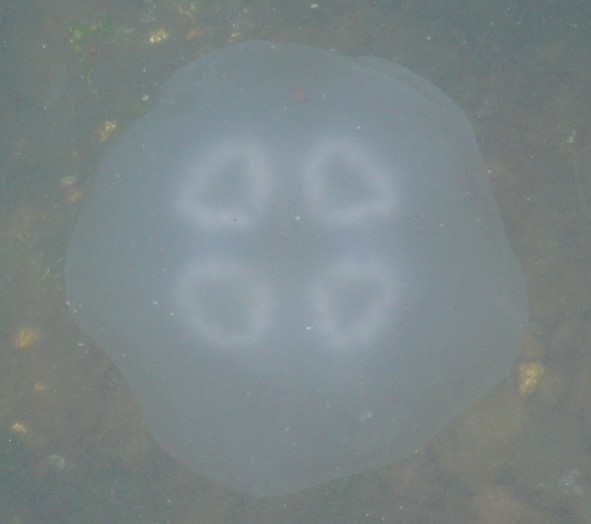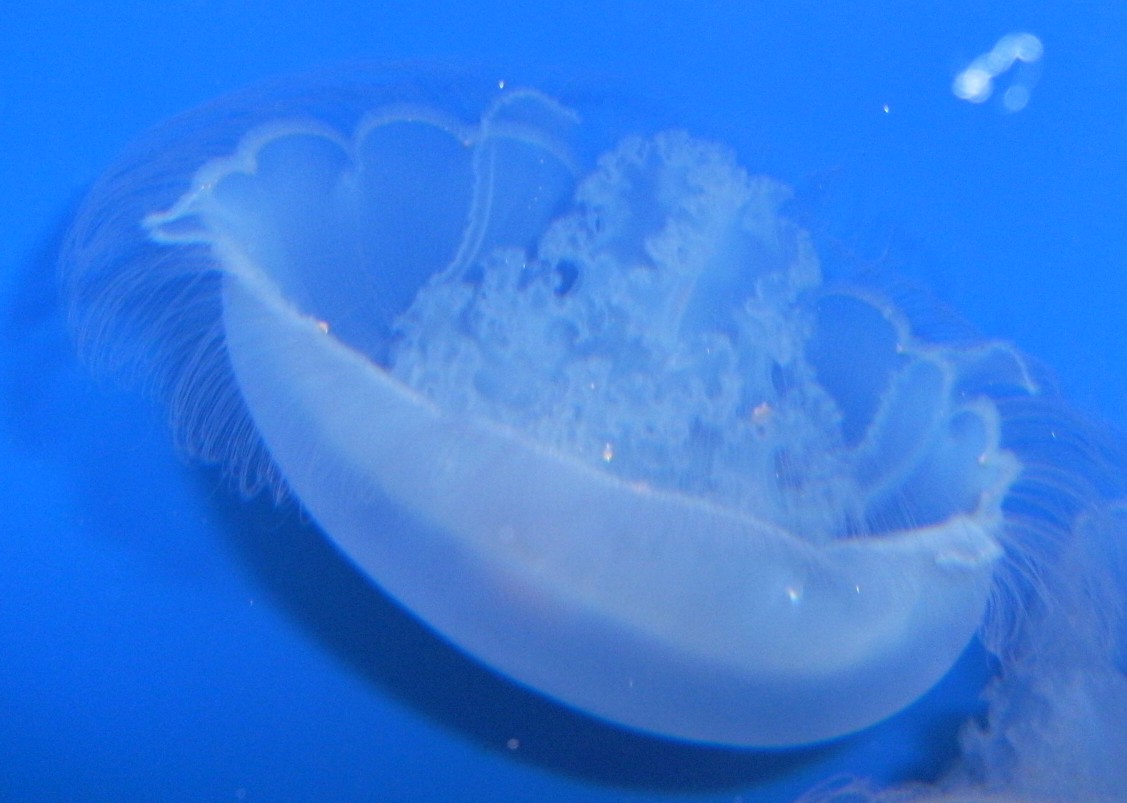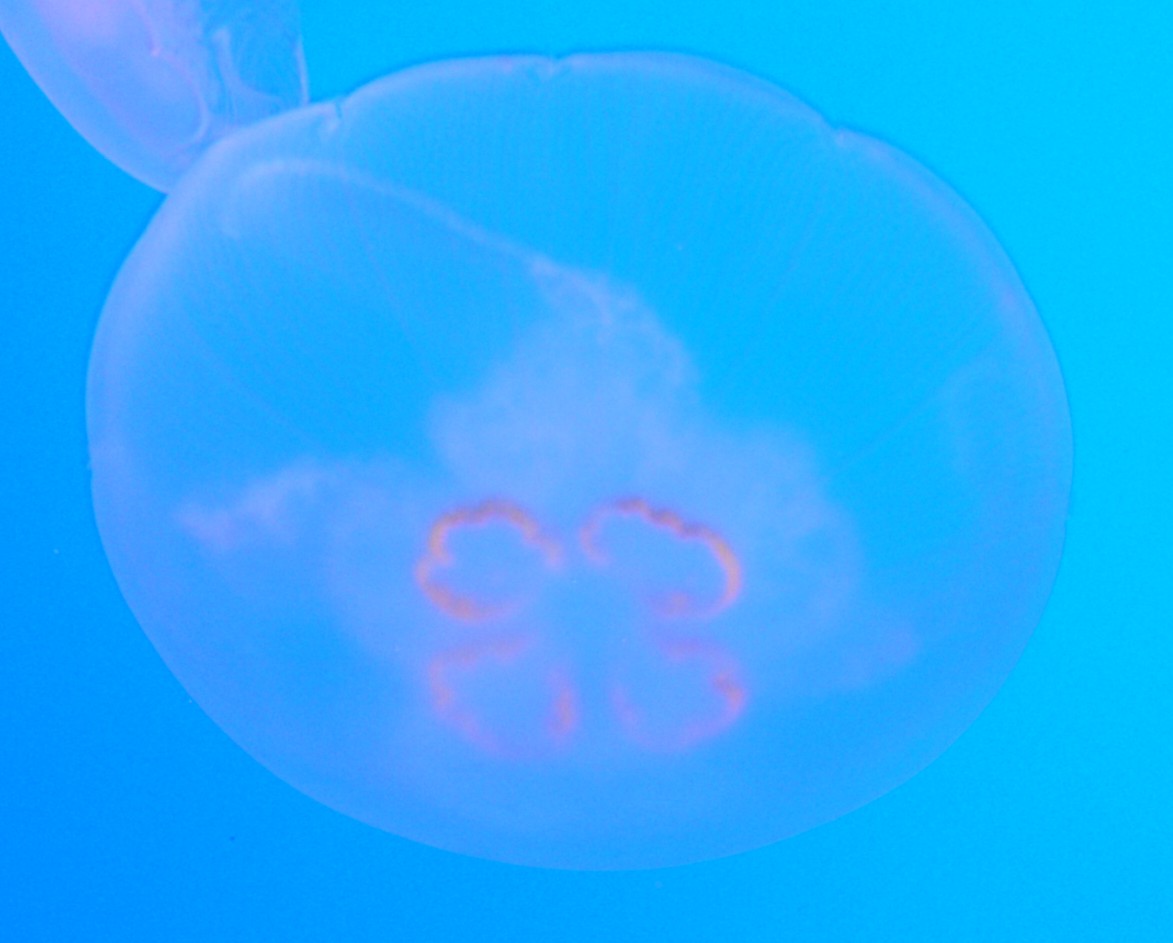Aurelia labiata (Linnaeus, 1758)Common name(s): Moon jelly, Common jellyfish |
|
| Synonyms: Aurelia aurita |  |
| Phylum Cnidaria
Class Scyphozoa Order Semaeostomae Family Ulmaridae Subfamily Aureliinae |
|
| Aurelia labiata, about 15 cm diameter, drifted near shore at Keystone ferry, WA | |
| (Photo by: Dave Cowles, August 2006) | |
How to Distinguish from Similar Species: The rare Aurelia limbata has profusely branched subumbrellar canals and the margin is dark brown. It is found off Alaska. Aurelia aurita is a very similar Atlantic and Baltic species which has 8 rather than 16 marginal lobes and has unbranched rather than anastomosing adradial canals. Until recently A. labiata along this coast were thought to be A. aurita.
Geographical Range: Found in most seas, from the poles to the tropics. Includes seas off Europe, Japan, Gulf of Mexico, E. US. Probably not native to the Pacific Coast of N. America, but now can be found all along the coast at times. May have originally been from Europe.
Depth Range: Shallow pelagic. Often washes up on beaches.
Habitat: Pelagic, inshore and offshore (often in large aggregations in our area)
Biology/Natural History:
Abundance
of this species varies widely seasonally and from year to
year. Females
of this species carry young larvae on the inner edges of the oral arms.
Scyphistomae
can sometimes be seen in large numbers attached on floating docks or on
protected rocks in the lower intertidal, and are about 1 cm long when
extended,
with long tentacles. In central CA the scyphistomae
are seen beginning in February and strobilate
around March. In Washington they strobilate
January to April (Purcell
et al., 2009). The medusae
grow rapidly and are sexually mature by June. Most medusae
die after reproducing but some live a second year. Polyps
(scyphistomae)
feed by predation like small anemones. The medusa
feeds by capturing small organisms such as copepods on mucus, which is
then moved to the mouth by cilia. The medusa
seems to make little use of nematocycts in capturing food.
Individuals
of this species from cold waters can survive being frozen solid in
ice.
The species appears to migrate toward the surface during the day and
downward
at night. The umbrella pulsing originates in one of the eight
rhopalia,
and spreads via the nerve net. When starved, this species can
shrink
dramatically in size while retaining functionality. The
tentacles
of this species may trigger a slight rash. The species is
sometimes
eaten by blue rockfish Sebastes mystinus.
| Return to: | |||
| Main Page | Alphabetic Index | Systematic Index | Glossary |
References:
Dichotomous Keys:Kozloff 1987, 1996 (As A. aurita)
Smith and Carlton, 1975 (As A. aurita)
Carlton, 2007
General References: (Most
refer to A.
aurita)
Brusca
and Brusca, 1978
Gotshall,
1994
Gotshall
and Laurent, 1979
Johnson
and Snook, 1955
Kozloff,
1993
Lamb
and Hanby, 2005
McConnaughey
and McConnaughey, 1985
Morris
et al., 1980
Niesen,
1994
Niesen,
1997
Ricketts
et al., 1985
Sept,
1999
Wrobel
and Mills, 1998
Scientific Articles:
Costello,
John H., Sean P. Colin, and John O. Dabiri, 2008.
Medusan morphospace:
phylogenetic constraints, biomechanical solutions, and ecological
consequences.
Invertebrate Biology 127(3): 265-290
Gershwin, Lisa-ann, 2001. Systematics and biogeography of the jellyfish Aurelia labiata (Cnidaria: Scyphozoa). Biological Bulletin 201: 104-119
Mackie, G.O., R.J. Larson, K.S. Larson, and L.M. Passano, 1981. Swimming and vertical migration of Aurelia aurita (L.) in a deep tank. Mar. Behav. Physiol. 7: 321-329
Purcell, Jennifer E., Richard A. Hoover, and Nathan T. Schwarck, 2009. Interannual variation of strobilation by the scyphozoan Aurelia labiata in relation to polyp density, temperature, salinity, and light conditions in situ. Marine Ecology Progress Series 375: 139-149
Reum, Jonathan P., Mary E. Hunsicker, and Caroline E. Paulsen, 2010. Species composition and relative abundance of large medusae in Puget Sound, Washington. Northwest Science 84:1 pp. 131-140
Web sites:
General Notes and Observations: Locations, abundances, unusual behaviors:
This species was fairly common around Rosario Bay summer 2006. We observed one individual captured by what appeared to be Urticina crassicornis in about 18 m of water. According to Purcell et al., the scyphistema larvae of this species are common on the underside of docks near here, such as in Cornet Bay.
This view of the underside shows the frilly oral arms. Note that the tentacles are in an extended position. Photo by Dave Cowles at Monterey Bay Aquarium August 2010.
The gonads in this male are pink or lilac. Photo by Dave Cowles, August 2010 at Monterey Bay Aquarium
Authors and Editors of Page:
Dave Cowles (2006): Created original page
Edited by Dave Cowles, 2009

